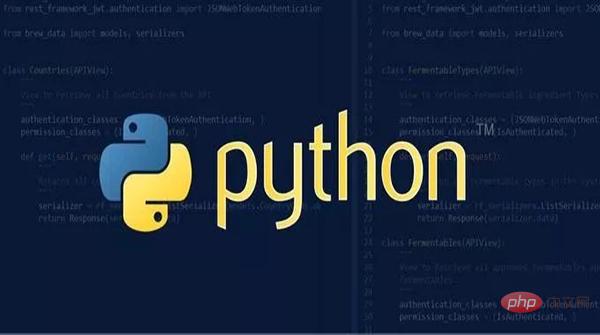 Backend Development
Backend Development
 Python Tutorial
Python Tutorial
 With four lines of code, Python can create beautiful pictures!
With four lines of code, Python can create beautiful pictures!
With four lines of code, Python can create beautiful pictures!

When we usually use some image processing software, we often see it adjusting the brightness, contrast, chroma or sharpness of the image. Do you think the underlying implementation of this technology is very advanced?
In fact, the most basic implementation principle requires only a few lines of code to be implemented in Python. After learning it, you can also perform simple image enhancement processing.
Which company is best at image enhancement
There is a class called ImageEnhance in the PIL module in Python. This class is specially used for image enhancement processing. It can not only enhance (or weaken) the brightness of the image, Contrast, chroma, and can also be used to enhance the sharpness of an image.
To use this module, you must first install the PIL library:
pip install pillow
Image enhancement processing
Read image
image = Image.open('girl.jpeg')
image.show()
Our original image is an innocent girl holding a tomato:

Brightness enhancement
enh_bri = ImageEnhance.Brightness(image) brightness = 4 image_brightened = enh_bri.enhance(brightness) image_brightened.show()
In order to make the contrast obvious, we enhance the brightness of the original image 4 times, look at the effect:

The enhanced image is overexposed. Is it a little dazzling?
Chroma enhancement
enh_col = ImageEnhance.Color(image) color = 4 image_colored = enh_col.enhance(color) image_colored.show()
Similarly, we enhance the chroma of the original image by 4 times to see the effect:

This The color of the picture is relatively strong, and I suddenly feel like I have changed from a young girl to a promiscuous woman!
Contrast enhancement
enh_con = ImageEnhance.Contrast(image) contrast = 4 image_contrasted = enh_con.enhance(contrast) image_contrasted.show()
Similarly, we enhance the contrast of the original image by 4 times to see the effect:

This image The details are highlighted very clearly, a bit like an early movie scene.
Sharpness enhancement
enh_sha = ImageEnhance.Sharpness(image) sharpness = 4 image_sharped = enh_sha.enhance(sharpness) image_sharped.show()
Similarly, we enhance the sharpness of the original image by 4 times to see the effect:

Sharp After the degree enhancement, it looks pretty good, and the change is not that obvious compared to the original image.
Summary
After reading this, do you feel it is very simple? The four most basic image enhancement skills can all be implemented with just one line of code. I am enhancing the image here. You can also do the reverse operation. You only need to adjust the coefficient to less than 1 to weaken the image.
Of course, in actual applications, we will definitely comprehensively optimize these dimensions to achieve the effect of beautiful pictures.
The above is the detailed content of With four lines of code, Python can create beautiful pictures!. For more information, please follow other related articles on the PHP Chinese website!

Hot AI Tools

Undresser.AI Undress
AI-powered app for creating realistic nude photos

AI Clothes Remover
Online AI tool for removing clothes from photos.

Undress AI Tool
Undress images for free

Clothoff.io
AI clothes remover

AI Hentai Generator
Generate AI Hentai for free.

Hot Article

Hot Tools

Notepad++7.3.1
Easy-to-use and free code editor

SublimeText3 Chinese version
Chinese version, very easy to use

Zend Studio 13.0.1
Powerful PHP integrated development environment

Dreamweaver CS6
Visual web development tools

SublimeText3 Mac version
God-level code editing software (SublimeText3)

Hot Topics
 1378
1378
 52
52
 Python: Exploring Its Primary Applications
Apr 10, 2025 am 09:41 AM
Python: Exploring Its Primary Applications
Apr 10, 2025 am 09:41 AM
Python is widely used in the fields of web development, data science, machine learning, automation and scripting. 1) In web development, Django and Flask frameworks simplify the development process. 2) In the fields of data science and machine learning, NumPy, Pandas, Scikit-learn and TensorFlow libraries provide strong support. 3) In terms of automation and scripting, Python is suitable for tasks such as automated testing and system management.
 The 2-Hour Python Plan: A Realistic Approach
Apr 11, 2025 am 12:04 AM
The 2-Hour Python Plan: A Realistic Approach
Apr 11, 2025 am 12:04 AM
You can learn basic programming concepts and skills of Python within 2 hours. 1. Learn variables and data types, 2. Master control flow (conditional statements and loops), 3. Understand the definition and use of functions, 4. Quickly get started with Python programming through simple examples and code snippets.
 Navicat's method to view MongoDB database password
Apr 08, 2025 pm 09:39 PM
Navicat's method to view MongoDB database password
Apr 08, 2025 pm 09:39 PM
It is impossible to view MongoDB password directly through Navicat because it is stored as hash values. How to retrieve lost passwords: 1. Reset passwords; 2. Check configuration files (may contain hash values); 3. Check codes (may hardcode passwords).
 How to use AWS Glue crawler with Amazon Athena
Apr 09, 2025 pm 03:09 PM
How to use AWS Glue crawler with Amazon Athena
Apr 09, 2025 pm 03:09 PM
As a data professional, you need to process large amounts of data from various sources. This can pose challenges to data management and analysis. Fortunately, two AWS services can help: AWS Glue and Amazon Athena.
 How to start the server with redis
Apr 10, 2025 pm 08:12 PM
How to start the server with redis
Apr 10, 2025 pm 08:12 PM
The steps to start a Redis server include: Install Redis according to the operating system. Start the Redis service via redis-server (Linux/macOS) or redis-server.exe (Windows). Use the redis-cli ping (Linux/macOS) or redis-cli.exe ping (Windows) command to check the service status. Use a Redis client, such as redis-cli, Python, or Node.js, to access the server.
 How to read redis queue
Apr 10, 2025 pm 10:12 PM
How to read redis queue
Apr 10, 2025 pm 10:12 PM
To read a queue from Redis, you need to get the queue name, read the elements using the LPOP command, and process the empty queue. The specific steps are as follows: Get the queue name: name it with the prefix of "queue:" such as "queue:my-queue". Use the LPOP command: Eject the element from the head of the queue and return its value, such as LPOP queue:my-queue. Processing empty queues: If the queue is empty, LPOP returns nil, and you can check whether the queue exists before reading the element.
 How to view server version of Redis
Apr 10, 2025 pm 01:27 PM
How to view server version of Redis
Apr 10, 2025 pm 01:27 PM
Question: How to view the Redis server version? Use the command line tool redis-cli --version to view the version of the connected server. Use the INFO server command to view the server's internal version and need to parse and return information. In a cluster environment, check the version consistency of each node and can be automatically checked using scripts. Use scripts to automate viewing versions, such as connecting with Python scripts and printing version information.
 How secure is Navicat's password?
Apr 08, 2025 pm 09:24 PM
How secure is Navicat's password?
Apr 08, 2025 pm 09:24 PM
Navicat's password security relies on the combination of symmetric encryption, password strength and security measures. Specific measures include: using SSL connections (provided that the database server supports and correctly configures the certificate), regularly updating Navicat, using more secure methods (such as SSH tunnels), restricting access rights, and most importantly, never record passwords.



